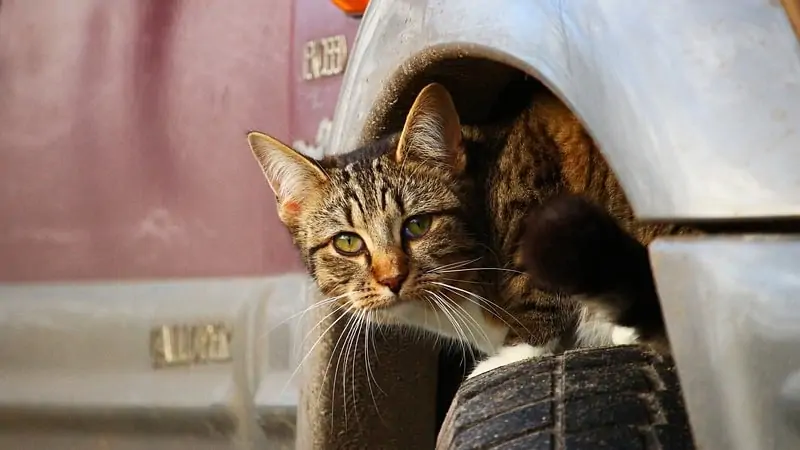The safety of your pets in a car is non-negotiable. One way to keep your cat safe in a car is to use a cat carrier. Unlike large dogs that have harnesses, you can attach to a seatbelt; a cat carrier doesn’t have one. So can you buckle in a cat carrier?
You can buckle in a cat carrier using a seatbelt. The safest place to buckle in a cat carrier is the back seat behind the driver’s seat. If your seatbelt cannot hold the carrier securely, there are other ways to secure the carrier in your car.
This article discusses whether it is bad to keep a cat in a carrier and if you can buckle in a cat carrier. I also provide information on the safest place in your car for a carrier.
Is It Bad to Keep a Cat in a Carrier?

It is okay to keep a cat in a carrier for as many hours as they are comfortable staying in one. Some cats can stay for up to eight hours in a carrier, without fuss. Other cats will require breaks every couple of hours.
If you are going on a long trip by road or flying with your cat, please do all you can to make your cat comfortable in the carrier or crate. Provide toys, medication for motion sickness, familiar blankets, and a scratchpad if necessary.
Feed your cat a few hours before taking any trip and pack extra food and water for longer trips.
Car rides give you the opportunity to make as many stops as you want to. If your cat gets restless after a while, stop and let them out of the carrier.
Please ensure that you have a leash on hand to keep them secure. Allow your cat to stretch its legs and play for a while before you get back on the road.
Can You Buckle in a Cat Carrier?
You can secure a cat carrier with a seat belt like you secure yourself with a seat belt. Most cat carriers do not have slots to insert a seatbelt through. To keep it stable, put the seat belt over the central seam of the carrier, and tighten the seat belt, so it doesn’t slide down.
If your seatbelt cannot truss the cat carrier or you have two or more carriers, you can buy bungee cords of assorted lengths to secure them. Use the latch anchors for car seats (found in cars designed from 2002) to connect the bungee cords, wrap them around the carrier, and secure it to other objects in the car.
Some pet safety centers in the US have warned against using a seat belt for a cat carrier unless the manufacturers of the carrier have done crash tests to prove that in an accident, the seatbelt will not crush the carrier.
How to Prepare for a Car Ride with Your Cat

Most cats rarely enjoy traveling and dislike getting into carriers and cars (it is traumatic for them). But your cat needs to visit the vet and maybe go on vacation with you. Since using a cat carrier is inevitable, here is what you can do to prepare your cat:
- Buy a pet carrier. It should be solid, easy for you to handle, well-ventilated, and fit your cat. The carrier should not be too little for your cat to sit and lie down, but it shouldn’t be too big for your cat to jump around.
- Get your cat used to the carrier by incorporating it into your normal home furniture. Allow your cat to explore it, keep the door open and occasionally close it with your cat inside the carrier.
- Ensure that your cat has and wears an ID tag (collar or microchip). If your cat manages to escape or an accident happens, pet services or a vet can return your cat to you. The tag should contain your cat’s name along with your contact details.
- Pad the carrier to keep your cat comfortable. First, place a layer of newspapers at the bottom of the carrier, then put a soft towel or cloth above it, and it will cushion your cat and absorb any accidents your cat might have on the trip.
- Put toys in the carrier to keep your cat occupied and reduce stress.
- Please make sure the carrier gate is securely locked and that your cat cannot escape by itself.
- Use a shade. If the carrier is directly under the sun, use a light material to cover it. It doesn’t matter whether your AC is on, and you should maintain ventilation even with the use of a cover.
- Adjust the temperature of your car. Cool it down in summer and keep it warm in winter. If it is too hot in summer, you can buy a cooling body mat for your cat.
- Before taking a long trip, start by taking short rides with your cat. You may circle the block or just go down the street. Encourage your cat with words and treats. Continuously increase the duration of the drive each time until your cat is comfortable enough for long trips.
Cat pheromone sprays like Feliway can help your cat adjust to a carrier easily. Before using the spray, ensure that your cat is not allergic to it. It also helps if you start carrier training from when your cat is little.
Cats that have experienced trauma relating to carriers may find it extremely difficult to use one. You can talk to a vet or an animal psychologist to find alternatives or ways to help your cat.
What’s the Safest Place in Your Car for a Carrier?

Now you’ve got your car safely tucked in the carrier, safety in the car is your next focus. The best place for a carrier is in the back seat. Because in accidents, the front or rear of the vehicle often receives the first impact, you should not keep the carrier on the front seat.
You can also cushion the carrier with boxes or suitcases on both sides to prevent it from falling. Another safe place for a cat carrier in your car is on the floor behind the passenger or driver’s seat. This position is very ideal for small cat carriers
Safely secured in the car, you are set for your ride!

